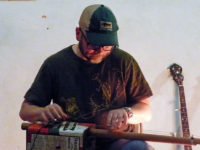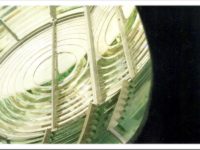Ross Hammond typically invests a lot into his recording projects, as we witnessed with instinctual rock-jazz excursions like 2012’s Adored and 2013’s Cathedrals. But having the sharp focus of marrying his music to an art exhibit with a social theme? Stand back.
Asked to perform at a local art show exhibiting the works of visual artist Kara Walker, the Sacramento composer, guitarist and bandleader embraced the challenge of devising a soundtrack of sort to the exhibit, perform it live with a six-piece band and capture the performance for his next record.
Humanity Suite (available May 6, Prescott Recordings) is the document of Hammond’s sound exhibit, a forty-seven minute opus that takes ideas already put forward on those prior albums and adapts them to a larger, longer-form platform. Those ideas involve writing for certain performers in mind, such as drummer Dax Compise and acoustic bassist Kerry Kashiwagi, and leaving enough elasticity to allow and encourage improvisation. Especially where that involves the horn players Catherine Sikora (tenor sax), Clifford Childers (trombone, euphonium, bass trumpet, harmonica) and Hammond’s mentor, Vinny Golia (soprano sax, flute, bass clarinet, singing bowls, shakuhachi, m’buot).
Putting all the movements together in a single performance enabled Hammond to transit from one sketch to another naturally and they often overlap, drawing attention to how the sections are related to each other and highlighting the coherency throughout all the changes.
Hammond’s lonely voice on guitar sets the initial mood, helped along by Compise’s sympathetic brush work as the horns arise from the mist to add their counterparts. The second phase begins with Kashiwagi’s understated bass figure, but things soon get a little agitated with horns improvising in opposition to Hammond. Hammond increasingly bares his teeth, getting into an early period John McLaughlin state of mind. At about the twelve minute mark everyone stops except for the three horns who then briefly battle then forge a truce, leading to a harmonious period of peace. Tension builds up with the introduction of a new motif, keyed by a winning bass clarinet solo from Golia while Hammond adds intriguing chords.
A groove develops around twenty-seven minutes in, with an ostinato played on bass at the center of it. It’s during that time when Hammond delivers his best guitar moment of the performance; there’s a human element in the way he constructs his impassioned lines, they never sound hackneyed at all. Following that passage, Sikora, Childers (on trombone) and Golia (on soprano sax) conjure up a nice commotion together for a while. The groove quietly exits, leaving behind a corridor of atonality and tentativeness, unexpectedly led by Childers’ harmonica. A new, hopeful riff from Hammond’s rhythm guitar emerges from the dirge, and Golia and Sikora extrapolate their thoughts from that. Hammond enters the fray switching to a lead role, leading to a crescendo, and then it’s just him alone up front briefly. Strains of harmonica can be heard in distance during the final breaths of the whole suite, bringing the whole thing to a conclusion as benign as the beginning.
It’s a long, kaleidoscopic ride, with enough interesting developments along the way to make that three quarters of an hour go by quickly. As to how closely related Humanity Suite is to Walker’s art, we who haven’t attended the exhibit and performance will have to take Ross Hammond’s word on that. The music, however, is a fine work of art on its own.
- Dave Douglas, feat. James Brandon Lewis – ‘Gifts’ (2024) - April 11, 2024
- Thollem – ‘Worlds In A Life, Two’ (2024) - April 8, 2024
- Oceans And [Tim Berne, Hank Roberts + Aurora Nealand] – ‘Lucid/Still’ (2024) - April 3, 2024




